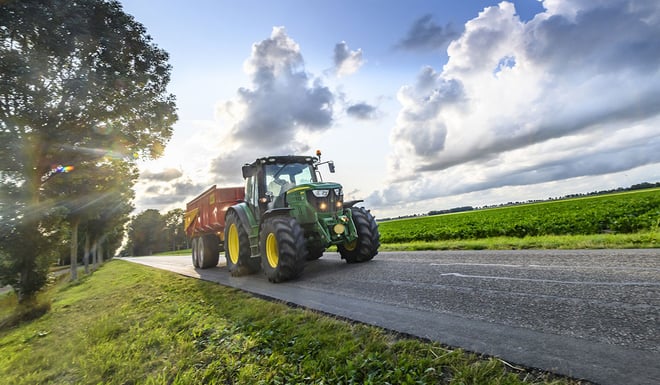As opposed to car or motorbike tyres, agricultural tyres, by definition, are not meant for the road. In reality, however, the time spent by tractors on the road is constantly on the rise due to the increasing distance between plots of land.
At the design stage, the priority for a tractor tyre is often a question of traction capacity on soft soil, which explains the height and width of the tyre, but also the lugs which provide maximum traction efficiency on the loose ground on which they must grip.
As you know, this is not the case at all on the road, where the tyre is simply placed on a very hard surface and where the contact is limited to the tip of the lugs. But are there tractor tyres that are more suitable for the road and what should we expect from them?
1. Resistance to wear
Asphalt is much harder than earth and is abrasive like sandpaper due to its composition. Road surfaces are effectively designed to last and to resist all types of traffic and the harshest possible weather conditions. A road surface is made up of several materials such as tar, sand, gravel and bits of crushed rock. These various granulates rise up to the surface of the road and form rough, sharp irregularities more or less spaced apart.

Driving for several hours on the road leads to more rapid wear to your agricultural tyres.
On a dry asphalt road, only the tips of the tyre lugs are solicited, the thickness of the lugs is not used and the rubber deforms to embrace the indentations in the road.
- If you drive quite slowly: the slippage rate on the road is as low as possible, therefore there is little wear.
- If you drive more quickly: the more you accelerate, the more the tyre will slip on the ground, which raises the temperature of the rubber, making it more supple and more sensitive to the abrasiveness of the asphalt. Speed often means much harsher braking or even abrupt braking which will have a maximum impact on wear, with the entire casing subject to significant strain, especially if the tyre loses its grip during braking.
As well as the tiny indentations in the surface of the ground, other factors may provoke premature wear to the tyre, such as the state of the road surface or carrying out manoeuvres in the farm’s courtyard for example.
The secondary country roads used by agricultural vehicles are often much less well maintained, the road surface may be deformed in places linked to an old road design such as cambered roads which result in lateral wear to the tyres, or they may have lots of potholes and debatable repairs which are often poor quality.
Each knock or impact to the agricultural tyre will accentuate wear and the speed factor is decisive in reducing this wear.
2. Driving comfort
Obviously, we expect impeccable road handling from our tyres as well as comfort, rapidity and no vibrations. We also hope that we won’t have any road handling problems when driving at speed. Unfortunately, this is not always the case, and this is often linked to a geometrical misalignment of your tyres.
This may be due to impacts when going too fast from field to road (or inversely), excess speed on a damaged road surface or path, when crossing over deep tracks or when you drive too often and too fast over deep ruts which cause a strain on your geometry.
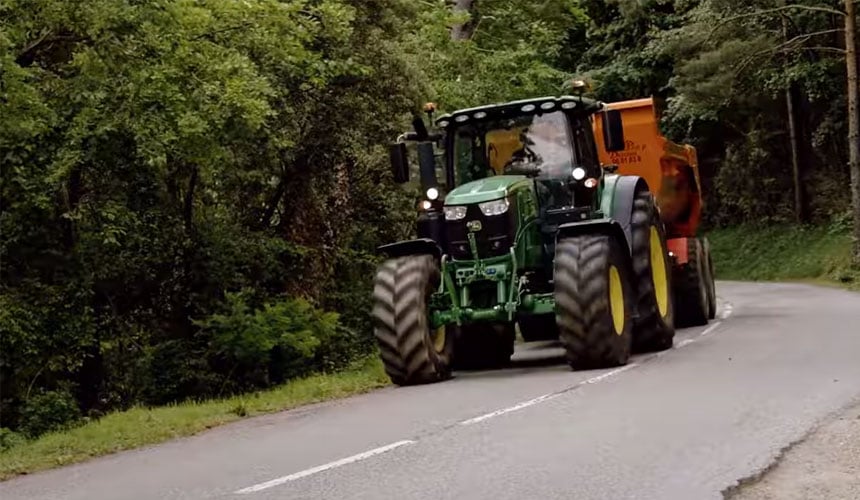
According to statistics, more than 37% of vibrations and agricultural tyre wear are caused by geometric faults, especially lack of parallelism. This phenomenon results in misalignment of the vehicle’s wheels. As opposed to problems of camber which involve the vertical axis of the wheels, parallelism concerns the horizontal axis settings. There is a problem with parallelism when from a front-on view the wheels are not perfectly parallel to the longitudinal axis of the vehicle.
In order to enjoy perfect driving comfort on the road, you must deal with geometrical problems as a priority, by checking your tractor parallelism regularly. This is also one of the best ways to limit irregular wear and preserve your tyres while making savings of several thousand euros by keeping your tyres for longer.
3. Health protection
A poor quality tyre or incorrect balance generates a varying degree of vibrations which can be felt in the tractor cab. These vibrations are absorbed above all by the tyres, they pass through the front axle and the cabin and end up reaching the driver’s seat.
Tyres, which are not manufactured with high quality standards, could potentially have concentricity problems which, when driving at speed (over 20 km/h) provoke vibrations at the steering wheel and in the cabin or even excessive rocking movements in the cabin.
Beyond the driving discomfort that this can cause, the health risks of these frequent and repeated vibrations should not be overlooked. Certain of these vibrations are effectively not absorbed by the different mechanical elements and may even have a negative effect on the driver’s metabolism by penetrating parts of the body in three different directions:
- Back to chest
- Head to foot
- Right to left
The level of vibrations to which the farmer is exposed is directly linked to the time spent behind the steering wheel of the tractor.
The medical services which specialise in agricultural social security distinguish between two types of vibrations, which are “hand-arm” (in the case of portable apparatus) and “whole body” (for the use of complete agricultural machinery). Farmers who drive agricultural vehicles are therefore exposed to this latter type of vibrations.
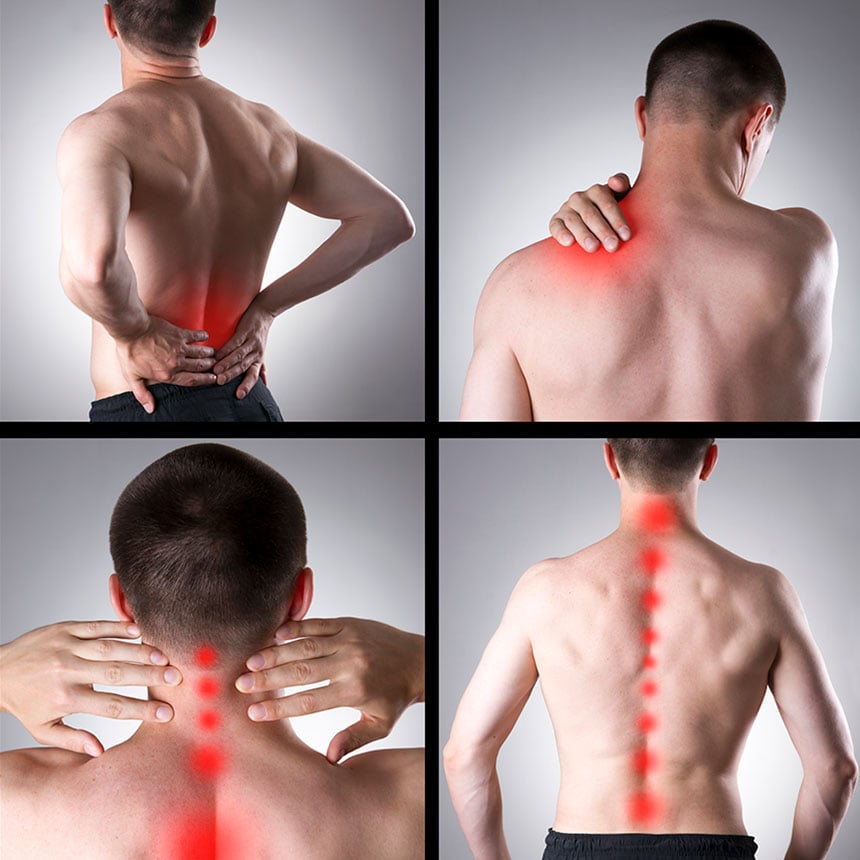
The following are among the different health consequences caused by excessive tractor vibrations, in order of importance:
- Musculoskeletal disorders (MSD), are the most frequent.
- Premature ageing of the intervertebral disc: the more the spinal chord subsides, the higher the risk of back pain (herniated discs, sciatica, lumbago).
- Visual disorders in the event of prolonged exposure to vibrations.
- Digestive disorders.
4. Main tyre criteria’s for road
If your business involves a large percentage of time spent on the road, it is important to make the right tyre choice. You can base your choice on various criteria, such as:
- tyre technology,
- tread volume,
- tread compound,
- resistance of the tyre to stress caused by the load.
Choose the most suitable technology for your activity. Standard technology tyres will, by nature, be more suitable for intensive road use than IF or VF technology tyres.
Indeed, the real benefit of IF and VF tyres is in the field, where they are used at low inflation pressure to better protect the soil. On the road, they provide a high level of driving comfort but can increase pitching at low inflation pressures. Standard technology tyres, due to their sidewall construction, significantly reduce pitching.
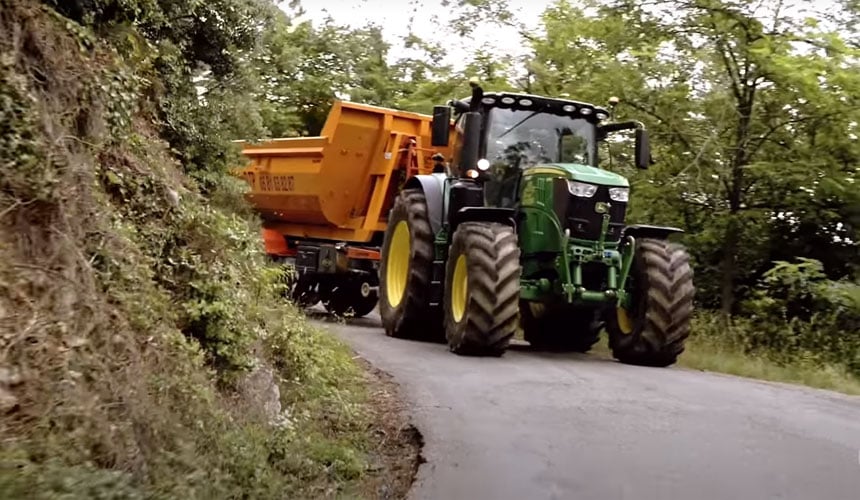
More rubber to wear
The volume of rubber is also an essential criterion, as on the VX-TRACTOR, whose has additional rubber volume up to 20% more than competitors* with its higher, wider, longer lugs. Its characteristics confer on this high-tech tyre features for potentially extended lifespan, even with intensive use on the road.
* Based on Bridgestone measurement tests conducted on Bridgestone VX-TRACTOR, Michelin MACHXBIB and Trelleborg TM900 on 710/70 R42 and 600/70 R28 tyres
Controlled wear
A tyre's tread compound is an extremely precise formula combining multiple components, and each formula used will give the tyre its properties.
For a car, this is part of the difference between a summer tyre and a winter tyre.
For a tractor tyre, this formula can influence the tyre's ability to resist wear and cuts.
For the VX-TRACTOR tyre, the proportion of vegetable oils has been increased. This has resulted in an improvement of more than 30% in wear resistance and more than 5% in cut resistance (compared to the previous generation of compound, based on controlled test (DIN abrasion test) (Accelerated ageing testing) conducted by Bridgestone R&D.).
Another important criteria is the casing resistance to stress
Choosing a high-tech tyre means that the carcass is optimised to minimise internal stress.
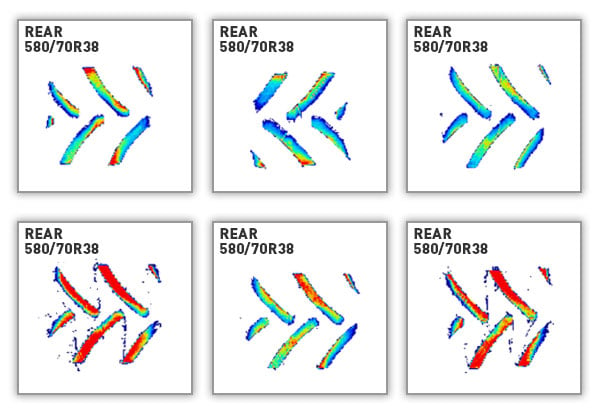 1. Measurement of ground pressure
1. Measurement of ground pressure
distribution from lowest (blue) to highest (red),
Bridgestone internal tests.
The same size of tyre used on the same tractor, with the same load per tyre, at the same inflation pressure will give different results depending on the brand of tyre(1).
1. Measurement of ground pressure distribution from lowest (blue) to highest (red), Bridgestone internal tests.
Why is this?
Because the internal construction elements (plies, bead, sidewalls, rubber compounds,...) and external construction elements (tread pattern, tread volume, sidewall reinforcement,...) are specific to each manufacturer.
This leads to different results.
Bridgestone's robust casing has been engineered to offer outstanding durability and resistance to damage, even at higher inflation pressures, thanks to robust tread belt, strong S-Line bead, reinforced sidewall area. Bridgestone tyres are well designed to resist heavy loads on road.
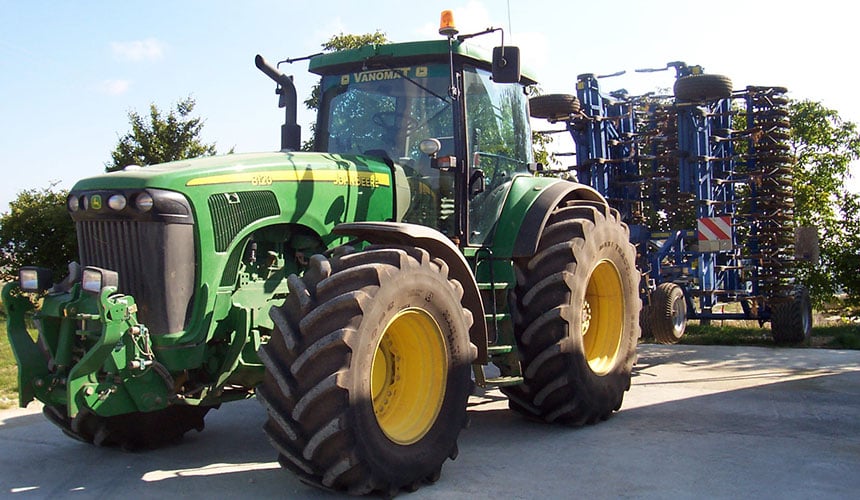
Conclusion
The ideal solution to be able to work on different terrains with complete peace of mind is to opt for:
A new generation tyre
which is designed to bring you every advantage on the road, without losing its agricultural capacities.
Adjust the pressure settings and parallelism
of your tractor as well as the hitched tools and implements, sprayers, spreaders, tanks, etc. to preserve the road handling qualities of your tyres.
Moderate speed
to maintain your tyres in good condition, but also for improving braking security.
The Bridgestone-agriculture.eu blog is written and administered by tractor tyre experts who are available to provide you with the advice you need on the subject of your agricultural tyres. They allow you to maximise your productivity with information on all subjects linked to tyres: Cheap tractor tyres — Technical data for agricultural tyres — Air pressure advice — Solutions to avoid soil compaction — Sprayer tyre pressure — Why and how to ballast your tractor tyres — When to use dual wheels — The mechanical causes of abnormal wear — Cheap agricultural tyres – etc…
To learn more and boost your farm's profits, Bridgestone-Agriculture is offering you a free, detailed white paper that explains the essential role your agricultural tyres play in your productivity.
Most people who read this article have also read some of the following articles:
This information is intended only to make you aware of the technical and functional aspects of agricultural tires and their use. It does not allow you to make a judgment or a definitive conclusion on a given problem. Only your agricultural tire expert is able to make a technical assessment and take a final decision, case by case.
Leave a
commentary
Your email address will not be published.
Required fields are indicated with *


